Creating an insightful customer feedback questionnaire can seem daunting. What questions do you include to not only garner responses but also drive your business forward? Our guide walks you through crafting a compelling questionnaire with 35 essential questions you can use immediately. Dive into the steps for effective questionnaire design, crucial areas for feedback, and tactics for maximizing the valuable data you collect without the fluff.
Key Takeaways
- Customer feedback questionnaires are a valuable resource for understanding customer expectations and experiences, shaping products/services, and fostering brand loyalty, all of which fuel business growth.
- Effective customer feedback surveys require setting clear objectives, choosing suitable question types (e.g., open-ended, multiple-choice, and scale questions), and balancing quantitative and qualitative data for a comprehensive view.
- To gather actionable customer insights, surveys should cover key areas such as product/service satisfaction, customer support experience, pricing perception, and brand loyalty and further be analyzed to drive improvement.
The Importance of Customer Feedback Questionnaires
Customer feedback surveys, also referred to as customer surveys, are not only a means of measuring satisfaction levels but also an opportunity to look into your customers’ thoughts and experiences with your brand. These invaluable insights can steer the course of your products/services to align closely with what truly matters to your customers. In doing so, you’ll elevate the quality of your offerings and foster brand loyalty in the long run.
Moreover, customer satisfaction surveys can turn satisfied and loyal customers into advocates for your brand. By sharing their positive experiences through word-of-mouth recommendations and referrals, they boost both credibility and cost-effective acquisition of new customers for businesses.
Ultimately, feedback from these questionnaires lays the groundwork for informed decisions that drive positive changes within your company and contribute to sustained success.
Designing an Effective Customer Feedback Questionnaire
Crafting a successful questionnaire for collecting customer feedback is a deliberate task that requires careful thought. It is essential to personalize your survey in terms of visuals and tone so it effectively connects with your target audience while also reflecting your brand’s identity. Defining specific goals, selecting appropriate question formats, and striking a balance between quantitative and qualitative data are all crucial elements in this process.
Each aspect will be discussed in depth below.
1. Determine Your Objectives
When crafting a survey, start by clarifying the purpose of gathering customer feedback. Whether it’s for refining products, gauging satisfaction with services, or assessing responses to new features, defining this objective ensures that all questions remain relevant and focused on the respondent’s experience. Asking irrelevant questions can lead to disengagement, potentially resulting in less accurate responses.
Setting the right tone at the beginning of the survey is equally crucial, as it encourages respondents to share honest feedback. Reassuring them that constructive criticism is valued creates a valuable means for pinpointing areas for improvement and identifying strengths within the products/services offered.
2. Choose the Right Question Types
To capture a wide range of customer opinions, it is essential to incorporate various question types in your questionnaire. You can achieve this by using different formats, such as open-ended questions – the “tell us more” type of questions – where customers are encouraged to provide detailed feedback in their own words. Multiple choice questions – the “pick one or more from a list” type of questions – allow for quantification of specific aspects of the customer experience. And Likert scale or rating scale questions – ask customers to rate their agreement, satisfaction, or frequency regarding a statement on a scale, typically from “strongly disagree” to “strongly agree” or from 1 to 5 (or 10) – which offer insight into changes over time and measure satisfaction levels.
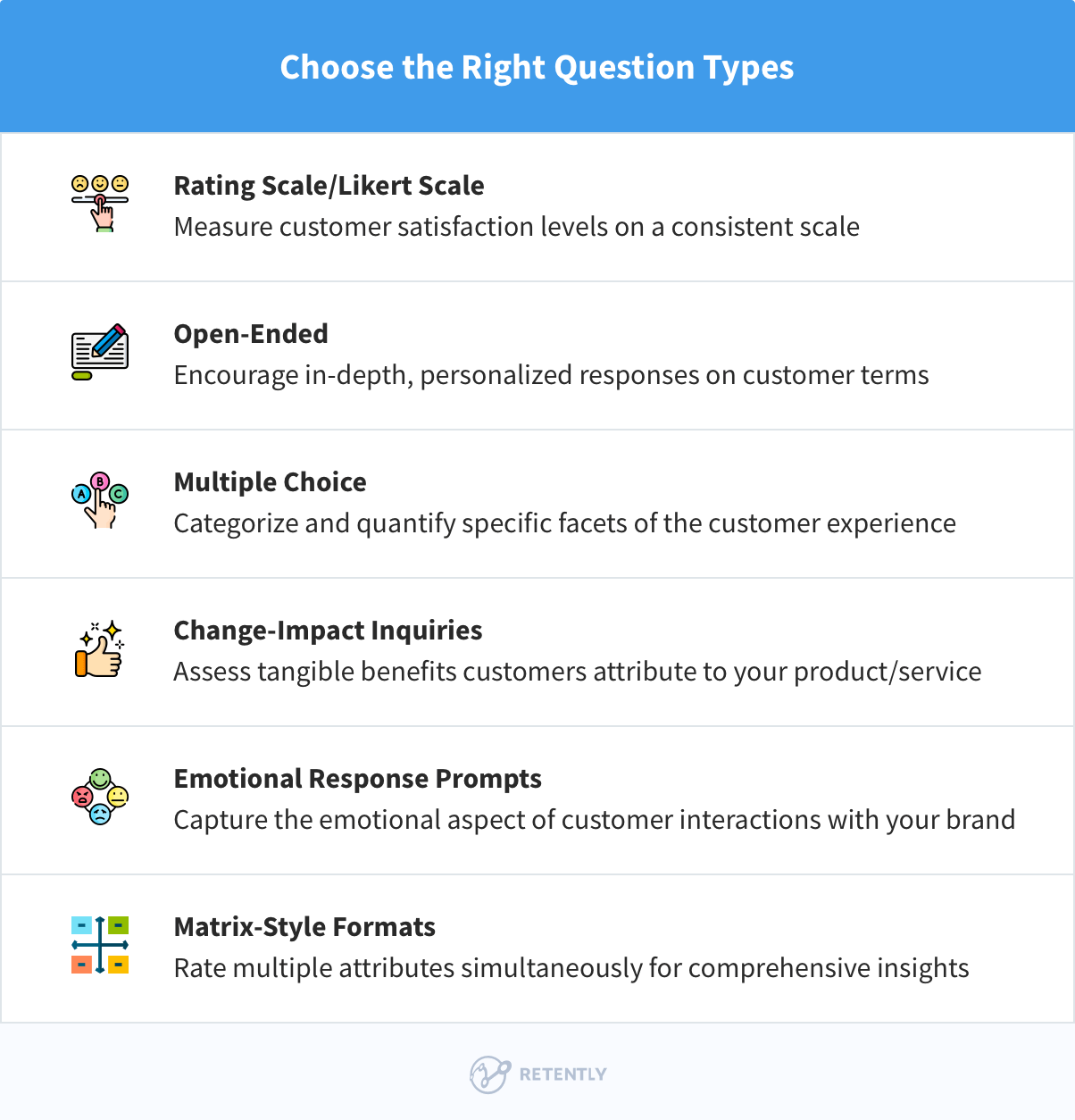
Combining these gives you a more rounded understanding of your customers. However, it may also prove beneficial to include additional question types that enhance these basic formats:
- Change-Impact Inquiries: These questions are designed to assess the tangible benefits that customers experience from using your products or services. Essentially, they aim to uncover how it has changed the customer’s life or business operations.
- Emotional Response Prompts: This type of question focuses on understanding customers’ emotional reactions when interacting with your company, products, or services. The goal is to gauge the emotional impact of your customer experience, whether it’s positive, negative, or neutral.
- Matrix-Style Formatting: This format presents a series of statements and asks customers to rate each one, usually on a scale. It’s like giving them a table with different aspects of your service and asking for their opinion on each. This method helps compare several items at once, providing a comprehensive view of customer attitudes towards various aspects of your business, from quality and usefulness to customer support and pricing.
Experimenting with different scales or changing how rating questions (like Likert scales) are set up can make it easier to get precise customer feedback. This can also help better understand how customers feel about their overall satisfaction with what they’re getting from you.
3. Balance Quantitative and Qualitative Data
To gain a thorough understanding of customer experiences and behaviors, use both quantitative and qualitative data. Quantitative methods can measure how involved users are in their journey with your business, helping you align your goals accordingly. Meanwhile, through qualitative feedback, one can delve into the reasons behind customer actions, adding depth to your analysis.
The mix of these two data types helps spot patterns and connections that can be further tested to improve the overall customer experience. By incorporating quantitative and qualitative information into an effective feedback loop system, ongoing collection and analysis become possible, ultimately leading to regular product updates based on customer input.
4. Tailor Questions to Audience Segments
To further enhance the relevance and impact of your questionnaire, consider segmenting your audience and personalizing questions accordingly. Tailoring questions to reflect the diverse experiences and perspectives of different customer segments can uncover deeper insights.
Segmentation can be based on customer demographics, purchase history, or interaction patterns. Personalized customer surveys can improve response rates and also yield more precise insights into specific customer groups. Incorporating questions that resonate with the unique experiences of each segment ensures that feedback is directly applicable to improving targeted aspects of your product or service.
For instance, questions designed for first-time buyers might differ from those engaged with long-term customers to capture the nuances of their experiences. This approach improves the relevance of your questions and shows your customers that you value their unique relationship with your brand.
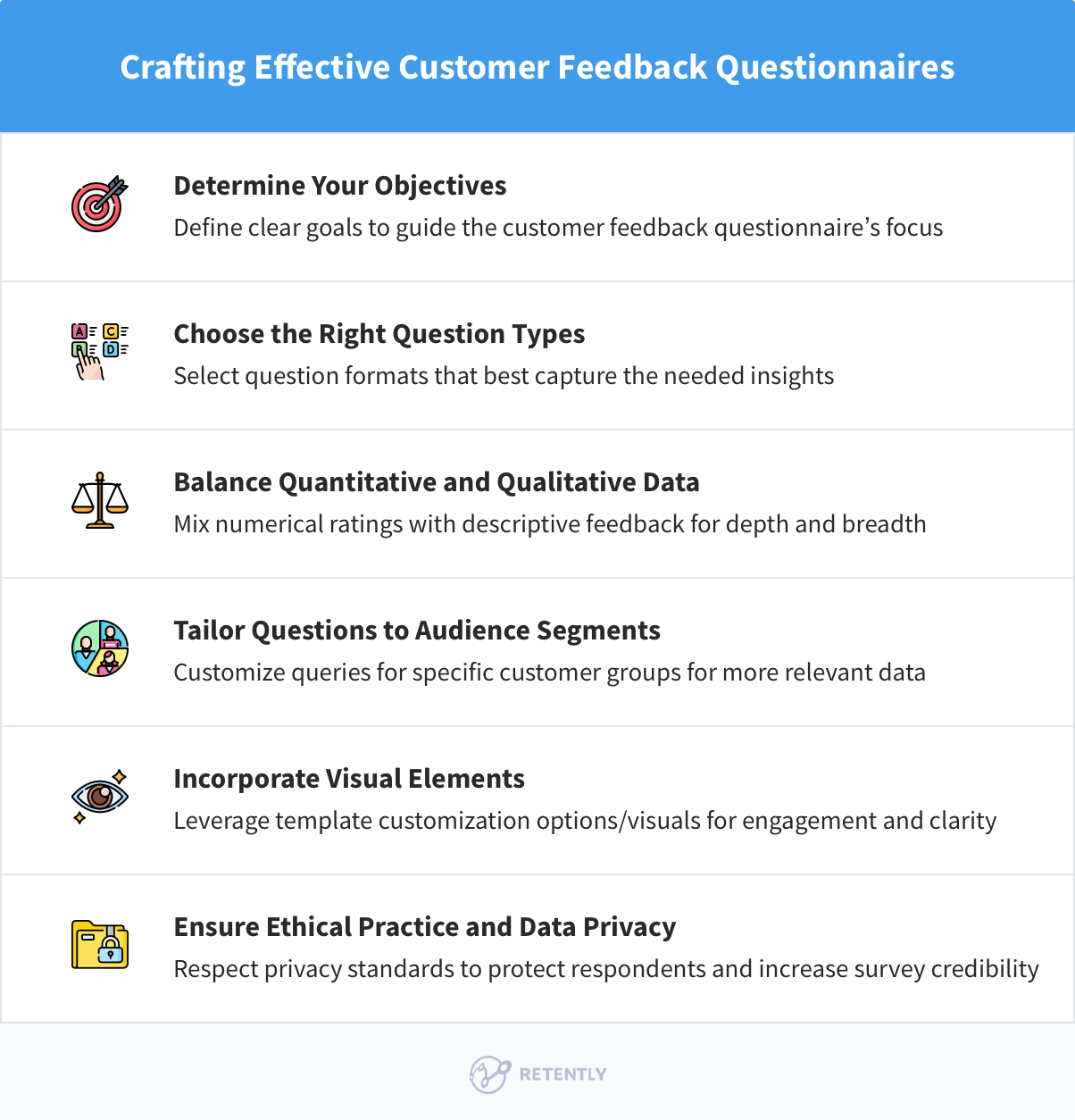
5. Incorporate Visual Elements
Kick off your survey by weaving in your brand’s identity – use your unique colors and text styles for customization. This approach makes customers feel connected, boosting engagement and response rates. It transforms the survey into an extension of their relationship with your brand, elevating their experience from the get-go.
Dive deeper by incorporating interactive and visual elements that resonate with the mobile user. Sliders for satisfaction, image selections for preferences, and clickable options turn feedback into an engaging conversation, making the process not just easy but enjoyable.
You can enrich this experience further with visual aids like infographics, charts, and videos to clarify the scope of the survey and add a visual punch. This breaks up the text and ensures your survey is appealing and easy to understand.
Make sure your survey software supports these features and is responsive across all devices. This seamless experience across desktops, tablets, and smartphones enhances feedback quality and shows your audience they’re truly valued. Personalizing and streamlining your survey invites deeper insights while reinforcing the bond with your customers.
6. Ensure Ethical Practice and Data Privacy
When data breaches are all too common, ensuring the privacy and security of respondent information is not just a legal requirement but a fundamental component of customer trust. Be transparent about your data use, informing participants how their feedback will be used and safeguarded. This transparency reinforces their confidence in your brand and encourages more honest and valuable responses.
Implement strict measures to protect customer data, including secure data storage, encrypted survey submissions, and restricting data access to authorized personnel only. Additionally, offer anonymity options and ensure the confidentiality of survey responses, further assuring participants of their privacy.
Regularly review and update your data protection practices to comply with evolving regulations like the GDPR. Putting privacy first when you collect feedback shows how much you value customer opinions. It’s a great way to build a strong relationship with them, which can lead to lasting loyalty.
Key Areas to Cover in Your Customer Feedback Questionnaire
To acquire valuable information, it is essential for your customer feedback survey questions to address important aspects, including:
- satisfaction with the product
- experience with customer support services
- perception of pricing
- loyalty towards the brand
Each category offers crucial data that can inform business strategies and enhance overall customer experience. It is imperative to thoroughly analyze these areas to gain insights that will benefit your company.
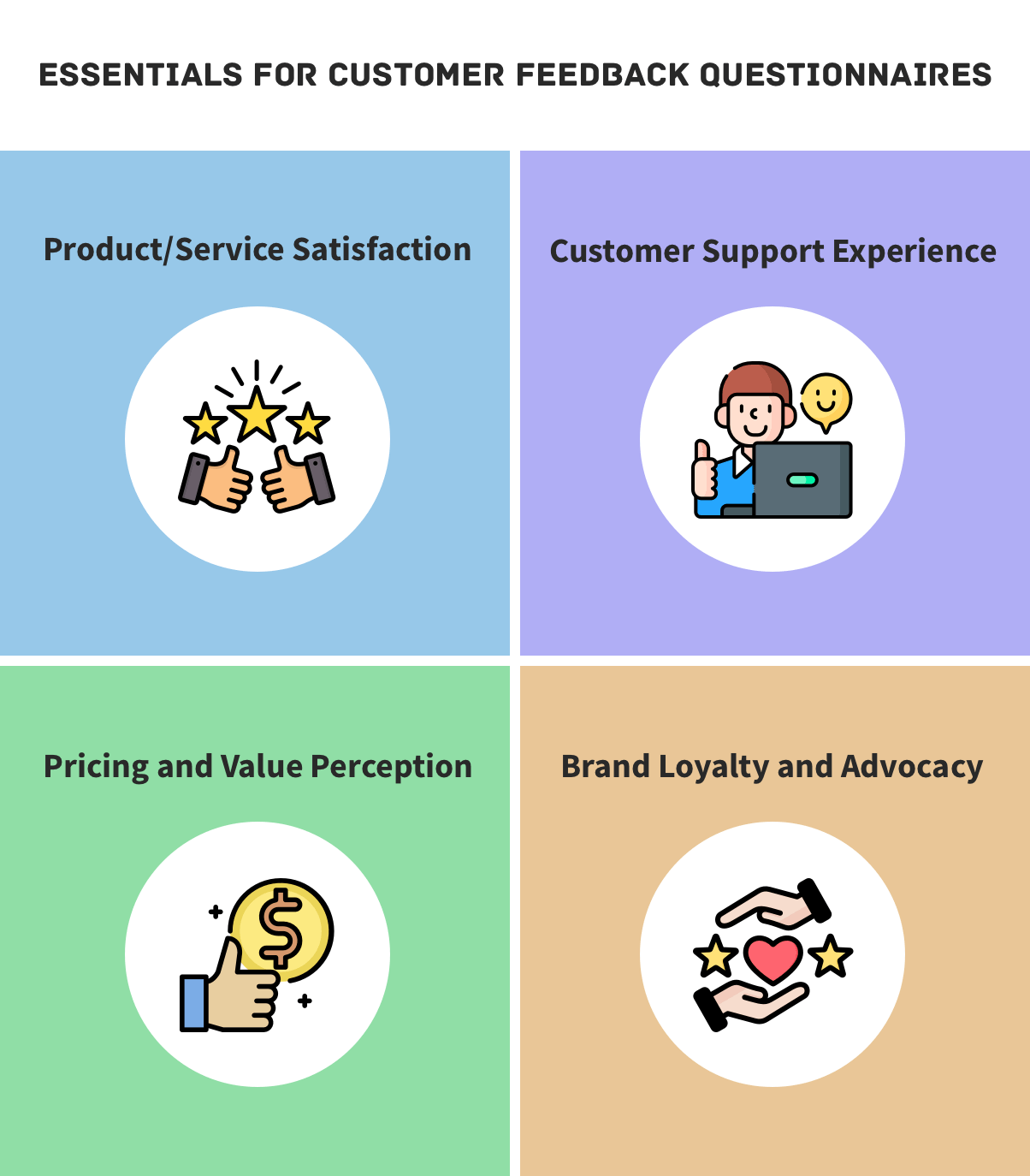
-
Product/Service Satisfaction
Evaluating satisfaction with a product or service is essential to any customer feedback form. It allows you to determine how well offerings meet customer needs and address their issues through targeted questions on satisfaction levels. A basic inquiry like “How pleased are you with our [product/service]?” can yield valuable insights as to where they stand in terms of Customer Satisfaction Score (CSAT). A ready-made customer satisfaction survey template designed specifically for this purpose can streamline the process and ensure that relevant queries covering all aspects of your offering are being asked.
Another way to measure product or service quality is by asking about the likelihood of recommending it to others via NPS surveys. Open-ended questions focused on goals such as “Can you provide insights into what prompted you to use this [product/service]? Understanding your objective will enable us to tailor our services better towards meeting your requirements.” helps understand why customers choose certain products/services and set expectations accordingly.
You can effectively refine your value proposition by understanding the challenges your offerings help address. Open-ended questions allow room to explore how consumers perceive the fulfillment levels of core needs met by your products or services.
-
Customer Support Experience
The feedback questionnaire should include a section dedicated to evaluating the customer support experience. One way to assess this is through the Customer Effort Score, which measures how easily customers can resolve their issues. Additional questions could focus on support teams’ speed and efficiency of resolution, as well as perceived professionalism and empathy.
Hence, among the main areas for measuring satisfaction with customer service representatives are hold times, problem resolution effectiveness, and both knowledgeability and attitude of customer service representatives. It’s also relevant to gauge whether or not customers feel that their feedback is valued and leads to tangible improvements in the quality of support services. This data can inform future strategies to enhance overall customer satisfaction.
-
Pricing and Value Perception
Gaining an understanding of how your customers view the price and value of your product or service is crucial in influencing their purchasing decisions and fostering loyalty. Asking questions such as “Do you believe our [product/service] justifies its cost?” can directly assess the perceived value customers associate with your offering.
Using rating scales to gauge customer satisfaction with pricing, comparing competitors’ offerings, and surveying opinions on pricing plans are effective ways to measure a customer’s perception of value for money. These insights into their satisfaction levels can guide strategic price adjustments while ensuring the delivery of satisfactory quality at competitive rates, ultimately improving the overall value proposition.
-
Brand Loyalty and Advocacy
The success of your business hinges heavily on brand loyalty and advocacy. A crucial aspect in measuring these factors is evaluating the alignment between customers’ personal values and those of your brand, as well as understanding why they choose to purchase from you over competitors. One effective way to gauge customer likelihood for recommending a product or service is through specific questions like the Net Promoter Score found on feedback questionnaires.
When seeking insights into the overall market perception of your brand, it can be beneficial to include advocacy questions that explore both positive and negative sentiments among customers. By understanding these perceptions, businesses can shape their strategies accordingly in order to foster loyal customers who actively advocate for their products or services.
Alternative Approach to Customer Survey Questions
As we shift our focus to specific question types aimed at comprehensively gauging customer sentiment, here is another approach to various inquiries tailored to uncover insights into the customer journey:
- questions to understand customer satisfaction
- questions to measure customer experience
- questions digging into customer loyalty
- questions fueling future progress
We’ll go through all of them for more details.
Questions to Understand Customer Satisfaction
1. General Satisfaction Questions
When it comes to the health of your business, customer satisfaction sits right at the heart. It’s the pulse that tells you how well you’re delivering on expectations and where you need to improve. Starting with general satisfaction questions in your customer feedback questionnaire is like asking, “How are you feeling?”. It’s a broad question that opens up the conversation.
These queries offer a snapshot of customer sentiment and can highlight areas that require a deeper dive:
- “On a scale of 1 to 10, how satisfied are you with our product/service overall?”
- “How likely are you to recommend our product/service to a friend or colleague?”
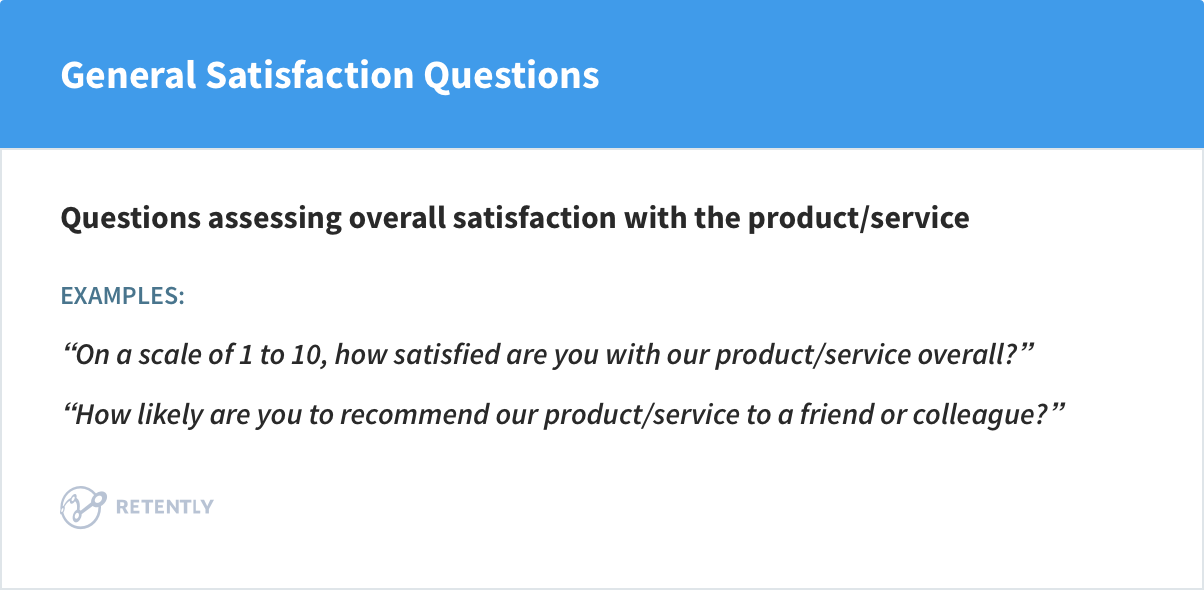
2. Specific Product/Service Feedback
After establishing a general understanding of customer satisfaction, let’s zoom in further with questions focused on particular aspects or features of your product/service. This section of your customer feedback questionnaire is where you get to the heart of what works, what doesn’t and why.
These questions should be carefully designed to extract detailed feedback about the different components of your offering. For instance, if you’re a software company, you might ask about the user interface, speed, or specific functionalities like data integration. If you’re in retail, questions might target product quality, variety, and the shopping experience. This approach helps you understand customer satisfaction at a granular level and identifies strengths to build on and weaknesses to address.
Here are some questions ensuring a nuanced understanding of customer preferences:
- “How satisfied are you with the level of customization options available for our software?”
- “How would you rate the clarity and effectiveness of the instructions provided with our product?”
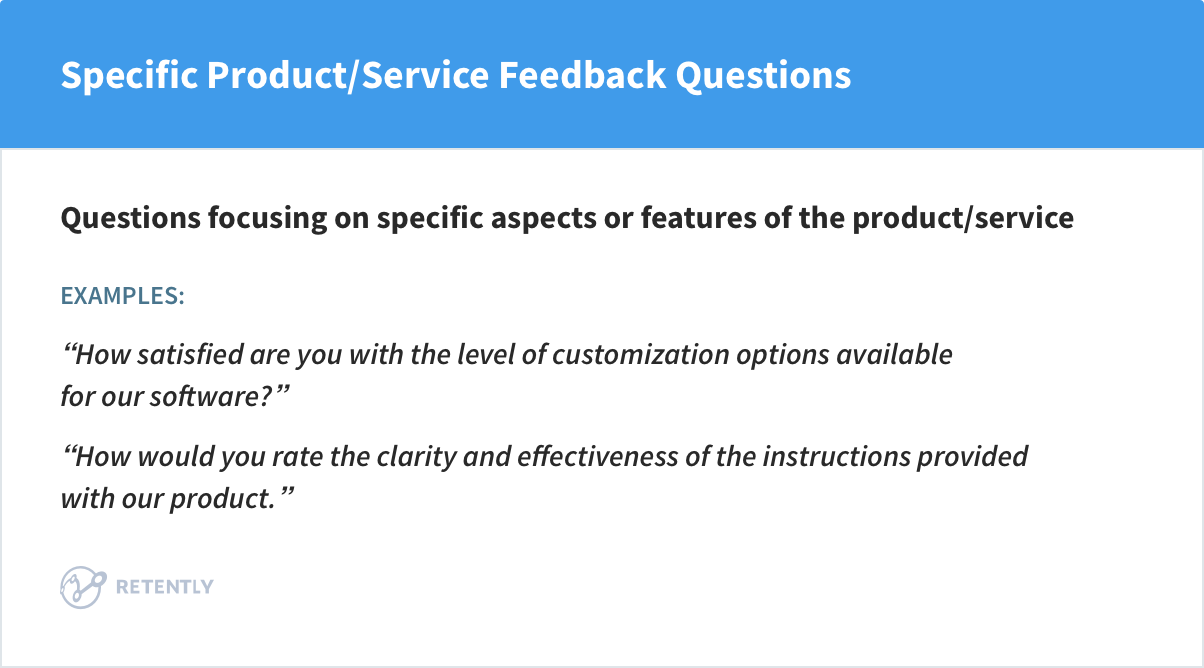
3. Promise & Delivery Gap
Moving further into the depths of understanding customer satisfaction, these questions encourage customers to reflect on their initial expectations versus their experiences, providing clear insights into where you stand.
Understanding these gaps is important for several reasons. First, it provides an opportunity to realign your offerings with customer expectations, either by enhancing the product/service or adjusting the messaging to set more realistic expectations. Second, it can guide your marketing team to craft messages that more accurately reflect the customer experience, thus building trust and credibility with your target audience. Moreover, this feedback acts as a direct input into your improvement processes.
Peering into the gap between promise and delivery, here are some question examples that gauge whether the product or service met or exceeded customer expectations:
- “Were there any features or functionalities that fell short of what you expected?”
- “Did our product/service meet your expectations based on our marketing materials?”
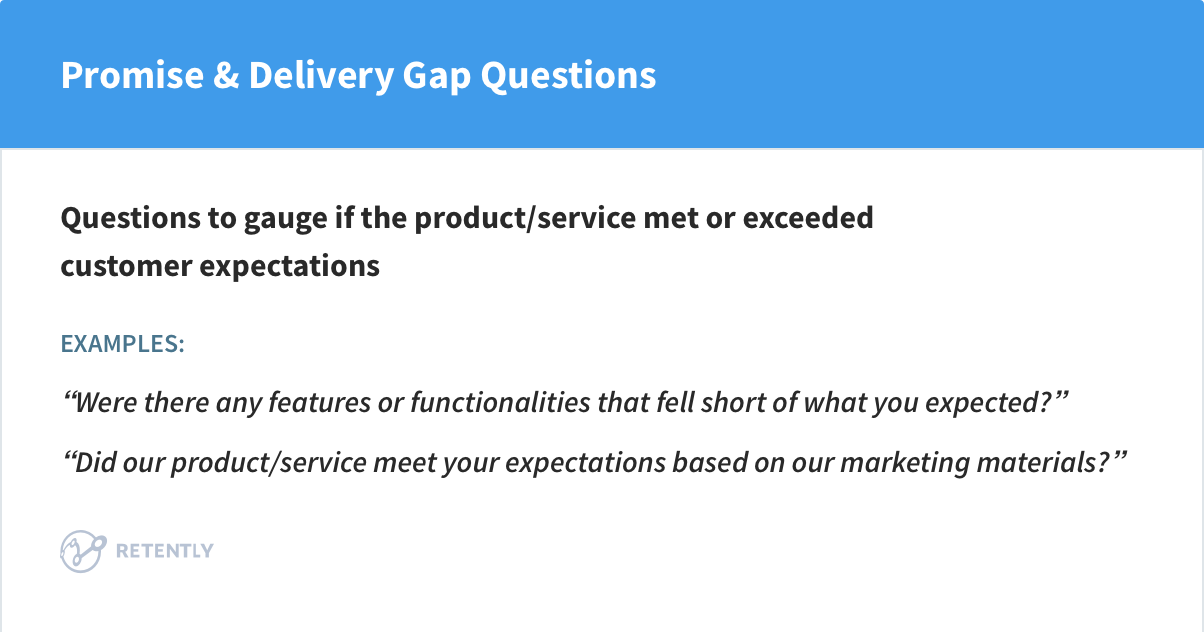
Questions to Measure Customer Experience
Now, let’s delve into questions that gauge the overall customer experience. From ease of use to interactions with customer service representatives, these inquiries provide valuable insights into every aspect of the customer journey.
4. Ease of Use and Accessibility
The rationale behind focusing on ease of use and accessibility is straightforward. When customers find your product or service easy to navigate and use, their overall experience improves. This not only boosts their satisfaction but also significantly increases their likelihood to stick with your brand. A low-effort experience can be a key differentiator in markets where competition is fierce.
Here are some question examples on how easy it is for customers to navigate and use the product/service:
- “How easy was it for you to find the information you were looking for on our website?”
- “On a scale of 1 to 5, how straightforward was it to set up your account with our platform?”
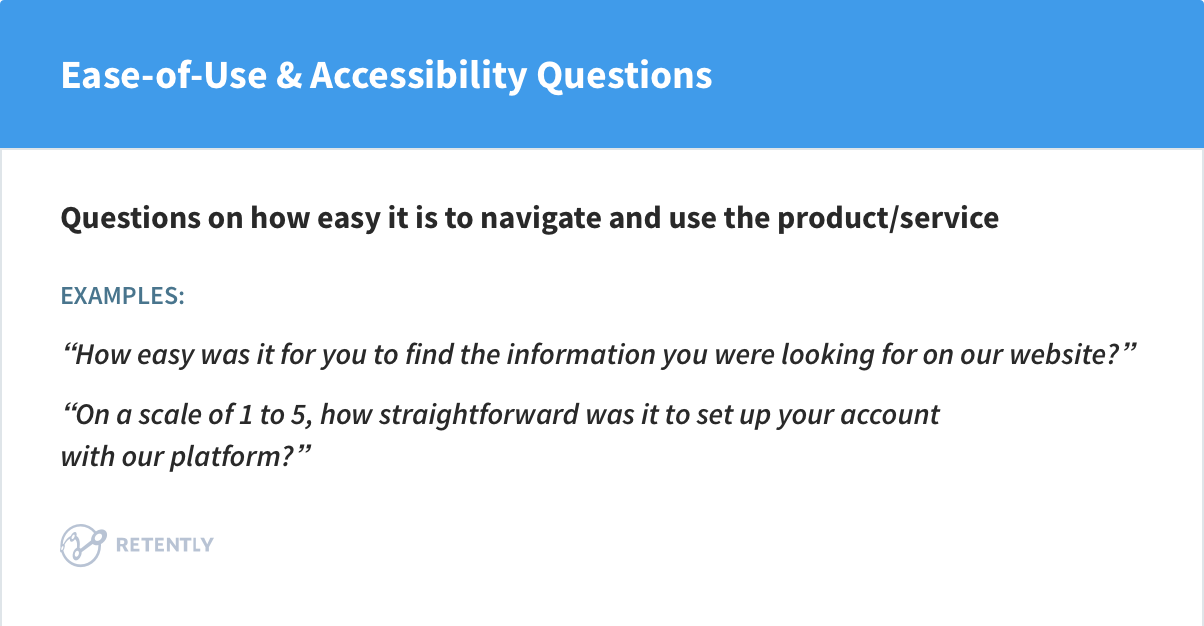
5. Customer Service Interaction
Customer service representatives are often the human face of your brand during critical moments of the customer journey. Incorporating these dimensions into your customer feedback questionnaire offers a dual benefit. It provides actionable insights to improve customer service quality and communicates to your customers that you value their opinions and are committed to providing exceptional service. This commitment can strengthen customer relationships and their perception of your brand as one that genuinely cares about their experience.
Questions aimed at evaluating customer service interactions should delve into both the effectiveness and the emotional aspects of the experience (how customers felt about the interaction). For example, you might ask:
- “How satisfied are you with the response time of our customer support team?”
- “How satisfied are you with the level of expertise demonstrated by our customer support team?”
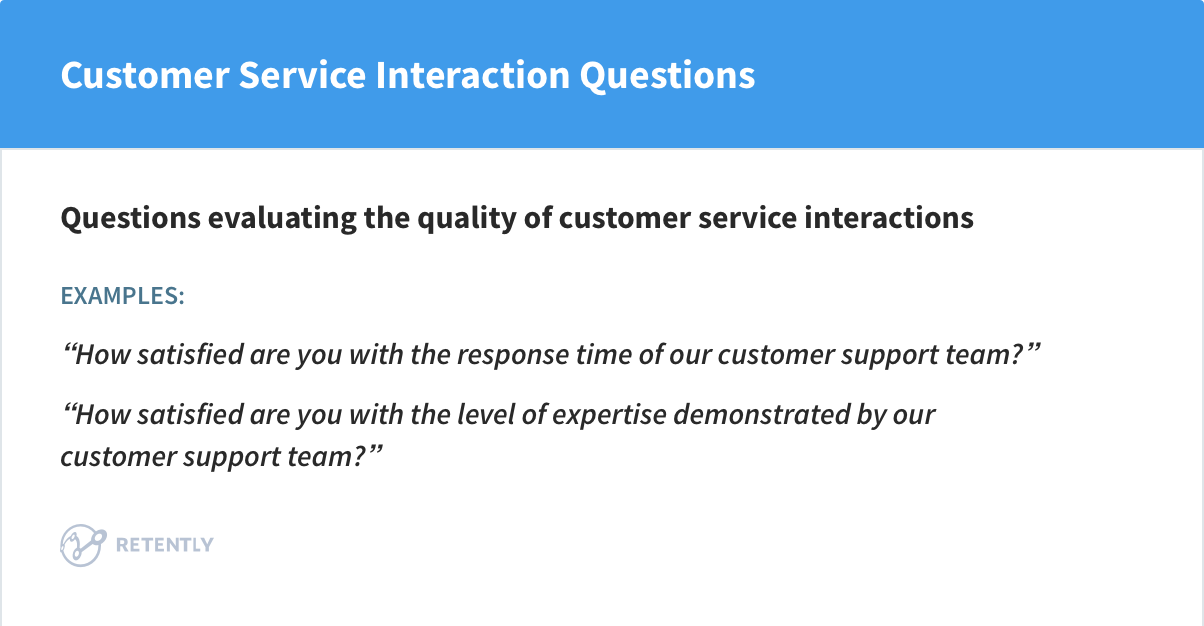
6. Problem Resolution
Feedback in this area can reveal much about the operational strengths and weaknesses of your customer service team. These questions can help identify if your processes are streamlined and effective or if there are bottlenecks and areas needing improvement. Questions in this section can be structured to gauge both the timeliness and the outcome of the resolution process:
- “Were you able to resolve your issue with our product/service in a timely manner?”
- “How satisfied are you with the solutions provided to address your problem?”
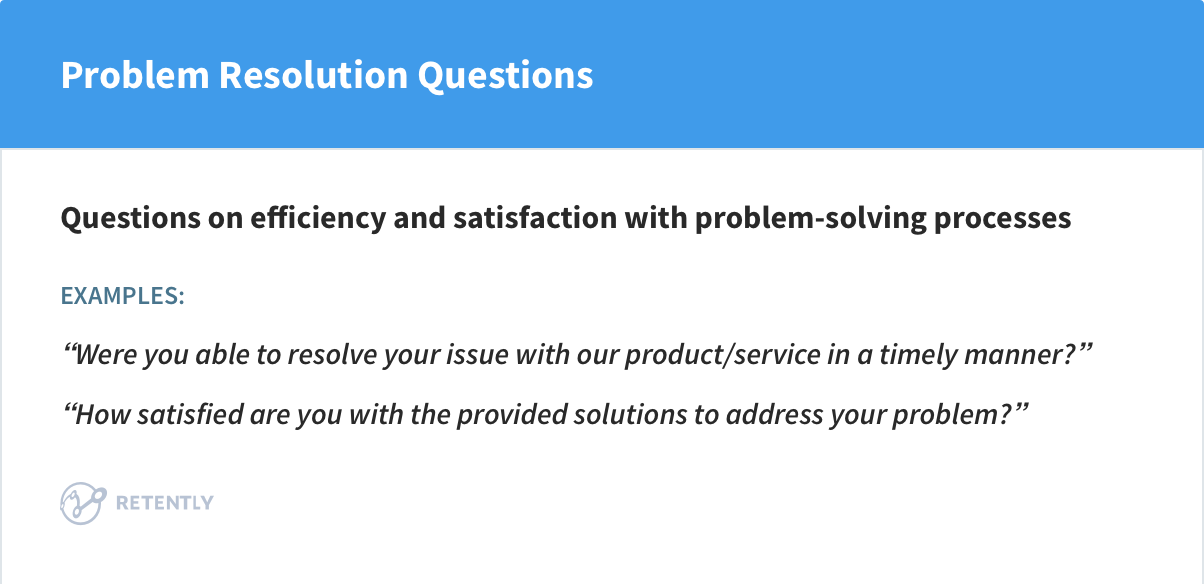
Questions Digging into Customer Loyalty
In the attempt to understand your customers better, measuring customer loyalty is akin to discovering a treasure map that guides your business toward long-term success. This is where Net Promoter Score (NPS) comes into play, a powerful tool that helps you see beyond the horizon of customer satisfaction to gauge the strength of your customer relationships. Our journey begins with questions that identify Promoters, Passives, and Detractors with NPS.
7. Customer Loyalty: Identify Promoters, Passives and Detractors
NPS simplifies the complex landscape of customer loyalty into a single, understandable metric. By asking one straightforward question, you can measure customers’ willingness to become brand ambassadors. Typically scored on a 0 to 10 scale, the responses categorize your customers into Promoters, Passives, and Detractors.
Why is this important? Because Promoters are more than just satisfied customers; they are the ones who will fuel your growth by recommending your brand to others. On the other hand, Detractors are unsatisfied customers who can harm your brand’s reputation through negative word-of-mouth. Understanding the balance between these groups gives you a clear indication of your company’s health and customer loyalty levels.
These queries gauge customer likelihood to recommend your product or service and delve into the reasons behind their score:
- “On a scale of 0 to 10, how likely are you to recommend our product/service to others?”
- “What is the primary reason for your score?”
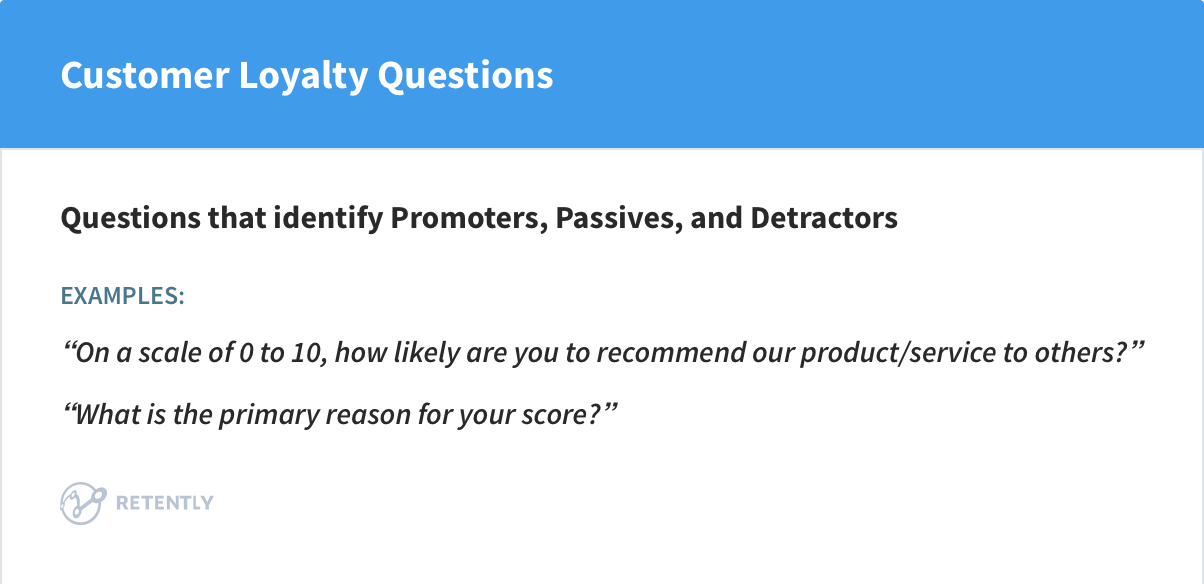
8. Repeat Business and Recommendations
After understanding the broad strokes of customer loyalty through NPS, it’s essential to zoom in on the specific behaviors that signal strong loyalty: repeat purchases and recommendations. These indicators reflect the health of your customer relationships and directly impact your business growth and sustainability.
These inquiries might serve as an example:
- “How likely are you to purchase from us again in the future?”
- “How likely are you to recommend our product/service to friends or family? Why or why not?”
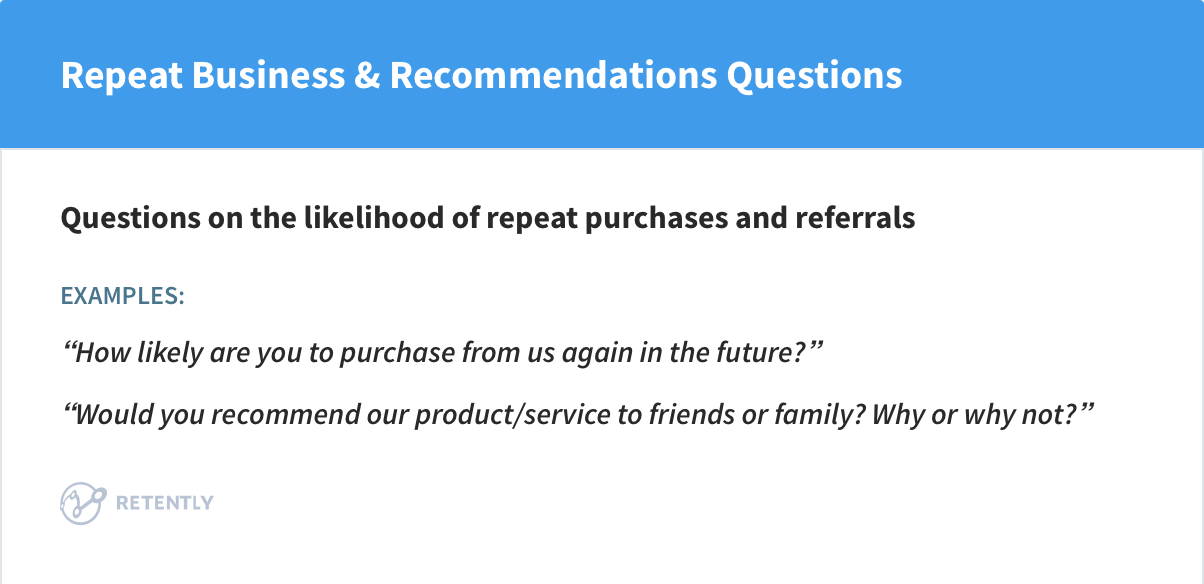
9. Customer Sentiment and Future Intentions
Beyond loyalty metrics and the likelihood of repeat business, understanding the broader sentiment customers hold towards your brand and their future intentions is essential for long-term engagement and growth. This segment of your customer feedback questionnaire focuses on capturing the emotional and forward-looking aspects of customer relationships with your brand.
Asking about future intentions allows you to gauge customer commitment and identify upcoming trends or changes in preferences that could affect your market position. Meanwhile, asking direct feedback on potential areas for improvement can provide a roadmap for innovation and refinement. It encourages customers to share their ideas and suggestions, making them feel valued and part of your brand’s journey.
Here are just a couple of examples:
- “How do you feel about the direction our company is heading in?”
- “What improvements would you like to see from us in the future?”
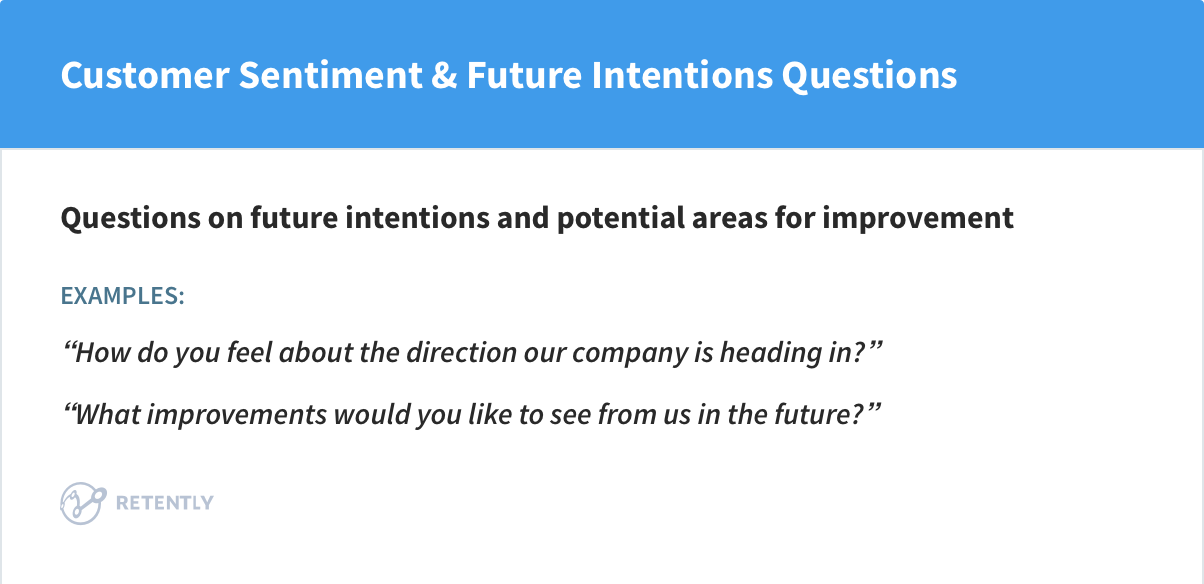
Questions Fueling Future Progress
These inquiries encourage honest feedback, invite suggestions for improvement, and gather contextual insights, empowering businesses to evolve and excel.
10. Open-Ended Feedback for Qualitative Insights
In the quest to truly understand and serve your customers, the richest insights often come not from checkboxes and scales but from the unfiltered, open-ended feedback they provide.
Gathering actionable insights from open-ended feedback involves careful analysis to identify common themes, suggestions, and areas of concern. It requires a willingness to read between the lines, recognize patterns, and prioritize changes that will significantly impact customer satisfaction and loyalty.
Our exploration begins with questions designed to elicit honest and constructive criticism of the customer experience:
- “Do you have any additional comments or suggestions about your experience with our product/service?”
- “What one thing could we do to improve your experience with us?”
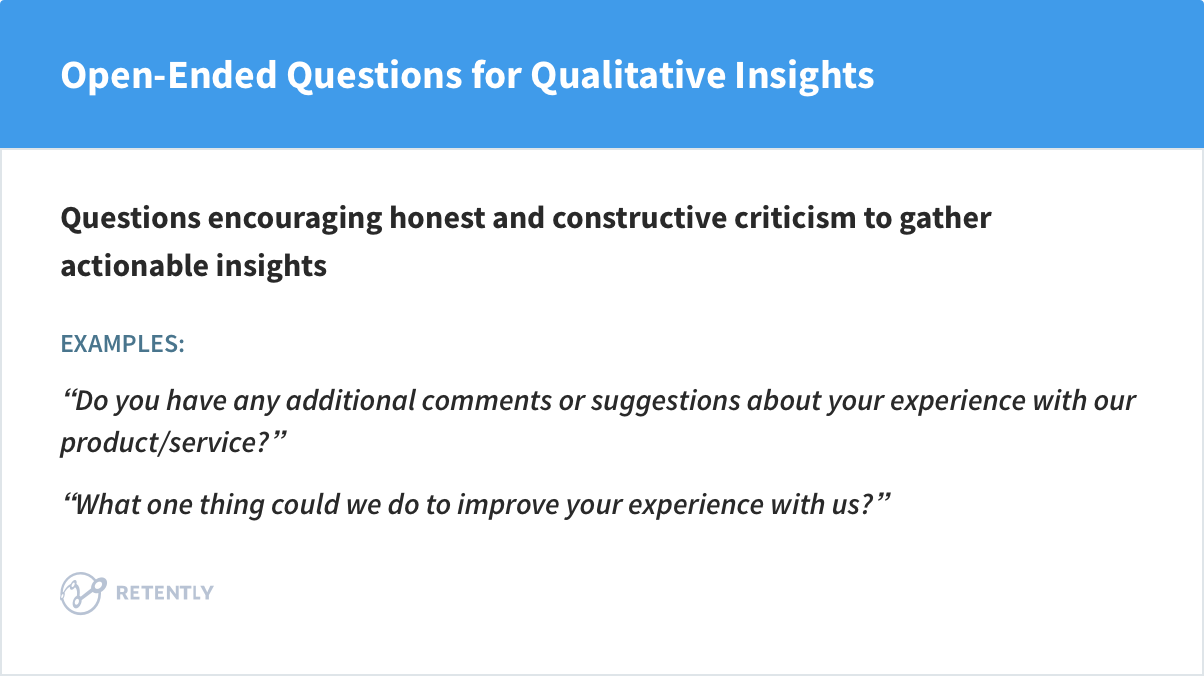
11. Suggestions for Improvement
Actively seeking suggestions for improvement from your customers is not just about identifying what needs to be fixed; it’s about opening the doors to innovation with those who use your products or services daily. This part of your customer feedback questionnaire should include open-ended questions encouraging customers to share their ideas and visions for brand improvement.
These types of questions serve multiple purposes. They signal to your customers that their opinions are valued and considered while providing a treasure trove of ideas to drive your business forward. Customer suggestions can highlight unseen opportunities, suggest new features, or point out areas of friction that your team might not have previously identified. You might use:
- “How can we enhance our product/service to meet your needs better?”
- “Is there a feature or service you wish we offered that we currently don’t?”
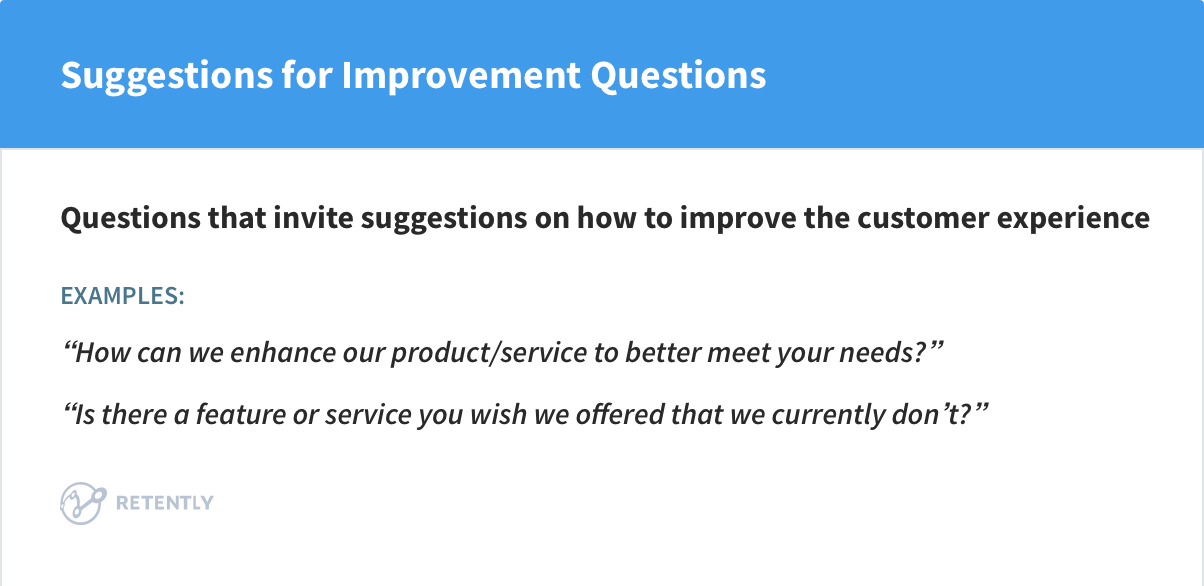
12. Demographic and Contextual Questions
Tailoring your questions to gather context-specific insights allows for more targeted improvements. It ensures that changes are not just based on general feedback but are informed by a deep understanding of how different customer segments use and benefit from your product/service. This approach can lead to more meaningful and impactful updates.
And here are some questions examples to explore:
- “Which devices do you primarily use to access our product/service?”
- “What is your preferred method of communication for receiving updates or promotions from us?”
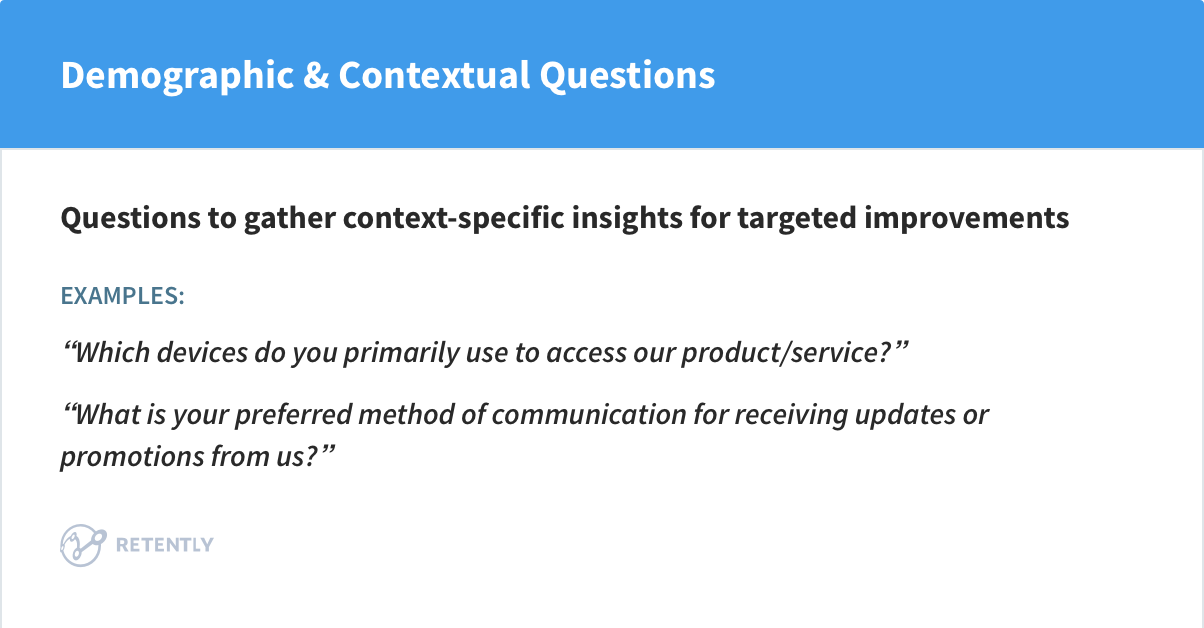
35 Essential Customer Feedback Question Examples
In the quest to understand customer satisfaction, strategic questioning is paramount. Businesses can uncover invaluable insights to refine their offerings and fortify customer retention by delving into specific areas and gauging feedback across various touchpoints.
Below are some additional practical customer feedback questions that can be used to gain insights into your products or services.
- Which aspects of our product/service do you find most beneficial?
- Which specific feature of our product/service could you not do without, and why?
- How often do you use our product/service in your daily activities?
- In what scenarios or environments do you find yourself most frequently using our product/service?
- Can you share your challenges while navigating our product/service?
- What is your favorite feature of our product/service, and why?
- In what ways has our product/service made a positive impact on your daily routine or work?
- Can you share a specific instance where our product/service significantly benefited you or your business?
- What key factor led you to choose our product/service over competitors?
- Compared to other options you’ve tried, what aspects of our product/service do you find more beneficial or lacking?
- Can you describe what specifically prompted your decision to purchase from us?
- Were there any hesitations or concerns you had before purchasing with us?
- How did you first learn about our product/service, and what influenced your purchase decision?
- Looking forward, what are the must-have features or improvements you would like to see in our product/service?
- If you could request one feature or improvement that isn’t currently available, what would it be?
- Have you encountered any significant issues or limitations while using our website or product/service?
- Are there any concerns or questions you have about our product/service that we can address? Please name them.
- Do you know someone who might benefit from our product/service? What are their needs or interests?
- How can we exceed your expectations and deliver an exceptional experience with our product/service?
- What differentiates our product/service from others in the market?
- How would you describe the quality of the customer support you’ve received from us?
- How would you rate your experiences with our customer support team? What improvements, if any, would you suggest?
- Could you share an instance where our product/service exceeded your expectations?
- Is there a feature you expected to find in our product/service but didn’t? What is it?
- In terms of pricing, how do you perceive the value of our product/service compared to its cost?
- Do you feel our product/service offers good value for the price? Why or why not?
- What personalized experiences or customizations do you wish our product/service offered to suit your needs better?
- What factors influence your decision to renew or not renew your subscription with us?
- How do marketing communications influence your perception of our product/service?
- How user-friendly do you find our product/service? Any suggestions for improvement?
- Could you provide feedback on the onboarding process for our product/service?
- Have any features of our product/service negatively impacted your experience? How can we improve?
- Can you share a feature you rarely use or find unnecessary? Why?
- Are there any industry-specific features you wish our product/service included?
- How satisfied are you with the updates/maintenance frequency of our product/service?
- What’s the one thing you wish you had known before you started using our product/service?
- Is there anything else you’d like us to know about your experience with our product/service?
Analyzing and Acting on Customer Feedback
Effectively leveraging customer feedback involves more than just examining it. Taking action is even more important. This includes identifying patterns, sharing findings with appropriate departments, and monitoring results.
These measures guarantee that the gathered information is successfully implemented into plans and initiatives to improve the overall experience.
1. Identify Trends and Patterns
Understanding customer perceptions and experiences is key to any business and achievable by identifying trends and patterns in their feedback. There are useful features available, such as word clouds or text analytics, which can help visualize common terms used by customers, as well as sentiment analysis of their feedback. These allow businesses to prioritize areas that need attention based on root causes or impact.
Analyzing customer feedback yields numerous advantages, from streamlining operations and strategic improvements to uncovering customer challenges and aligning with broader business objectives through customer experience metrics. By qualitatively analyzing responses, businesses can pinpoint recurring themes and pain points, fostering ongoing product and service improvements.
2. Share Results with Relevant Teams
Effective communication of customer feedback among teams is crucial for promoting a customer-focused approach within your organization. Qualitative data offers valuable insights for sales, marketing, product development, and customer success strategies. Directly sharing unfiltered comments with employees maximizes the feedback’s impact.
Using a centralized dashboard or reporting system enables real-time distribution of customer feedback across teams. Regular cross-departmental meetings to discuss this information and develop collaborative plans ensure that all areas focus on enhancing overall customer satisfaction.
3. Close the Feedback Loop with Effective Communication
After gathering and analyzing customer feedback, it’s time to close the loop with your respondents. Communicate your actions in response to their feedback to reinforce their value to your business and your commitment to excellent experiences. This follow-up not only strengthens customer relationships but also encourages future engagement. Whether through email updates, website announcements, or social media posts, keeping your customers informed about taken action demonstrates transparency and accountability.
Here’s how you can transform customer insights into meaningful improvements and communicate these changes effectively:
- Whenever possible, personalize your follow-up communications. A personalized email thanking a customer for their feedback and detailing the steps you’ve taken in response can significantly impact them. It shows a genuine appreciation for their input and reinforces their value to your business.
- For broader feedback trends or suggestions that have led to significant changes, consider public acknowledgment through your blog, newsletter, or social media channels. Sharing stories about how customer feedback has shaped your product or service builds a community around your brand.
- Be transparent about the feedback process. Share not just the changes made but also insights into the decision-making process. If certain suggestions cannot be implemented, explain why. This level of transparency builds trust and helps customers understand the complexities and limitations that businesses face.
- Invite customers to continue the conversation. Whether through a follow-up survey to gauge their reaction to the changes made or a forum where they can share ongoing thoughts, keeping the lines of communication open is key to a responsive customer feedback loop.
- Highlight customer success stories that have resulted from this feedback loop. Sharing real-life examples of how feedback led to improved customer experiences can be powerful in demonstrating your commitment to customer satisfaction.
4. Monitor Progress and Iterate
The implementation of a feedback loop for continuous improvement allows for consistent monitoring and iterative enhancement of progress. This process incorporates both quantitative and qualitative data, enabling ongoing collection, analysis, and implementation of improvements. Sharing direct customer feedback within the company encourages a strong culture of learning and results in more impactful changes in attitudes and actions compared to feedback delivered by management.
To promote a customer-centric approach among the team, you can integrate customer satisfaction metrics such as Net Promoter Score (NPS), Customer Satisfaction Score (CSAT), or Customer Effort Score (CES) into decision-making processes. Regularly reviewing these metrics will help identify any shifts in overall sentiment from customers. It is important to have systems in place that track the impact of implemented enhancements on satisfaction levels based on insights gained from customer feedback.
5. Leveraging Digital Tools
Building on the capabilities of specialized survey software, integrating advanced digital tools into our feedback mechanisms takes our customer engagement strategies to the next level. Beyond just collecting responses, interactive technologies embedded within these platforms can delve deeper into customer emotions and preferences, providing instant, actionable insights.
This evolution in feedback collection, powered by AI and machine learning, allows for nuanced analysis of open-ended responses, quickly identifying underlying sentiments and trends. It transforms feedback from a static input into a dynamic source of strategic intelligence, enabling businesses to adapt and respond quickly.
Social listening capabilities further extend the reach, capturing spontaneous conversations and opinions shared across social media platforms. This adds an invaluable layer of insights and offers a broader perspective on customer sentiment.
This integrated approach marks a significant leap forward, positioning businesses as leaders in customer-centric innovation and continuous improvement.
Tips for Maximizing Response Rates
Ensuring a high response rate is crucial in obtaining enough data for effective analysis. This can be achieved by minimizing the length and complexity of questionnaires, selecting an appropriate method of distribution, and strategically timing their administration. But let’s dive deeper into each:
-
Keep It Short and Simple
To improve customer engagement, it is essential to keep surveys concise and straightforward. It is recommended to limit the number of questions in a questionnaire to 5-10 for optimal length. Keeping surveys brief (around 3 minutes) or even just asking a single question can prevent respondents from dropping out mid-survey and increase completion rates.
In order to encourage customer participation, keep survey questions clear and easy to understand. For example, the use of simple rating scales such as five-star ratings can make it easier for customers to browse through the survey and provide feedback. This approach also shows value towards the customer’s opinion by acknowledging their honest feedback upfront and highlighting its importance in shaping future improvements.
-
Choose the Right Delivery Method
Choosing the appropriate platform for survey distribution is crucial in effectively reaching customers and aligning with their communication preferences. For example, younger demographics may respond better to SMS surveys, while in-app messages can generate higher participation rates and offer valuable contextual feedback from active mobile users.
Maintaining a clean email list ensures that surveys are only sent to engaged customers. Integrating surveys into various communication channels makes participation easier. By combining multiple survey channels such as email, web links, SMS messaging, and even on-site kiosks, businesses can cater to the preferences of different customer segments.
Employing a diverse range of platforms allows companies to gather insights from a wider pool of respondents without limiting themselves solely to one channel or age group’s perspectives. This multi-channel approach also enhances user convenience by meeting consumers where they prefer to engage, whether through traditional methods like emails or newer options like text-based interactions.
-
Time Your Questionnaire Appropriately
It is important to have a good understanding of the behavior and availability of your target audience in order to determine when it is best to send surveys for maximum engagement. Sending surveys immediately or within 24 hours after an interaction occurs has proven most effective in gathering transactional feedback. On the other hand, for relationship NPS feedback, intervals of every 30, 60, or 90 days are suitable.
For more relevant and timely customer feedback, survey distribution should occur right after purchase completion, following any customer support interactions, and promptly upon completing specific tasks such as online bookings.
Furthermore, in regards to B2B/SaaS customer journeys, it would be most beneficial to wait between two weeks and one month post-implementation before sending out a survey. This timing ensures that customers have enough time since their initial experience with the product/service to evaluate its effectiveness fully. It is also recommended that ecommerce companies gather information through surveys approximately seven days after delivery.
Wrapping up
A customer feedback questionnaire is more than a tool for gathering data – it’s a strategic asset, helping businesses understand their customers’ experiences, needs, and expectations. They offer valuable insights that can guide business decisions, drive product improvements and foster customer loyalty. To ensure meaningful feedback is gathered, they need to be well-designed with areas such as product satisfaction, customer support experience, and pricing perception covered.
However, the effectiveness of a feedback questionnaire depends on its ability to cater to different customer needs and touchpoints across the customer journey. From initial interaction to post-purchase experiences, different stages require tailored questions to capture relevant insights. This might involve measuring the customer effort score (CES) to assess ease of use, leveraging the Net Promoter Score (NPS) to gauge loyalty and the likelihood of recommendations to others, or measuring the customer satisfaction score (CSAT) to explore the nuances of the customer service experience.
Incorporating a blend of question types, from quantitative ratings to open-ended prompts, is essential. It paints a complete picture of customer sentiment across every interaction with your product or service.
But the journey doesn’t end with data collection. Thorough analysis, team collaboration, and strategic action turn insights into impactful change. Specialized survey software optimizes this process, empowering you to build deeper customer connections and drive sustained growth.
Ready to harness the power of customer feedback? Start today by incorporating Retently into your strategy and unlock the invaluable potential of data. Gather actionable insights that inform better decision-making and improve customer satisfaction for existing customers.

















 Christina Sol
Christina Sol 



 Greg Raileanu
Greg Raileanu 


